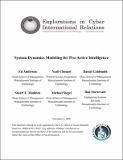| dc.contributor.author | Anderson, Ed | |
| dc.contributor.author | Choucri, Nazli | |
| dc.contributor.author | Goldsmith, Daniel | |
| dc.contributor.author | Madnick, Stuart E. | |
| dc.contributor.author | Siegel, Michael | |
| dc.contributor.author | Sturtevant, Dan | |
| dc.date.accessioned | 2022-04-07T16:16:11Z | |
| dc.date.available | 2022-04-07T16:16:11Z | |
| dc.date.issued | 2009-11-04 | |
| dc.identifier.uri | https://hdl.handle.net/1721.1/141749 | |
| dc.description | Final Report: Proactive Intelligence (PAINT)
CONTRACT FA8750-07-C-0101 ISSUED BY AFRL/IFKE CODE FA8750 6.
ADMINISTERED BY CODE N62879 USAF, AFMC AIR FORCE RESEARCH LABORATORY 26 ELECTRONIC PARKWAY
ROME NY 13441-4514 | en_US |
| dc.description.abstract | The Pro-Active Intelligence (PAINT) program, sponsored by the Intelligence Advanced Research Projects Activity (IARPA), was formed to address the challenges1 posed by distributed human networks, including terrorists and insurgencies, both independent and state-sponsored. In particular, certain threats (including emerging dual-use technologies) are difficult to detect using traditional intelligence means because: (a) indicators are difficult to discern and may give little warning time, (b) there is usually limited relevant data collection and integration capability, and (c) expertise is generally diverse and disconnected.
Over the course of 18 months from September 2007 to February 2009, an effort, led by researchers from MIT, was initiated to develop computational social science models to study and understand the dynamics of complex intelligence targets for nefarious technology activities (broadly defined as activities outside U.S. national interest). System dynamics models were developed because they offered great opportunities to (a) understand and represent determinants of nefarious technology development, (b) to identify aspects of critical pathways, such as resource management, towards the development of nefarious technologies, and (c) support a modeling based strategy for the identification of new sources of intelligence.
This report describes the “System Dynamics Modeling for Pro-Active Intelligence” effort and its two thrusts: (a) development of a comprehensive holistic system dynamics model to represent, understand, and differentiate nefarious and benign activities and (b) the development of a detailed system dynamics resource model that can be used as a component of a multi-method federation of models. In both cases, simulations were conducted to illustrate the effectiveness of these models in demonstrating system behavior and, on occasion, highlighting potentially counter-intuitive behaviors. | en_US |
| dc.description.sponsorship | CONTRACT FA8750-07-C-0101 ISSUED BY AFRL/IFKE CODE FA8750 6.
ADMINISTERED BY CODE N62879 USAF, AFMC AIR FORCE RESEARCH LABORATORY 26 ELECTRONIC PARKWAY
ROME NY 13441-4514 | en_US |
| dc.language.iso | en_US | en_US |
| dc.publisher | © Massachusetts Institute of Technology | en_US |
| dc.relation.ispartofseries | ECIR Working Paper No. 2009-4 | |
| dc.rights | Attribution-NonCommercial-NoDerivs 3.0 United States | * |
| dc.rights.uri | http://creativecommons.org/licenses/by-nc-nd/3.0/us/ | * |
| dc.title | System dynamics modeling for pro-active intelligence | en_US |
| dc.type | Technical Report | en_US |
| dc.identifier.citation | Anderson, E., Choucri, N., Goldsmith D., Madnick, S. E., Siegel, M., & Sturtevant, D. (2009). System dynamics modeling for pro-active intelligence (ECIR Working Paper No. 2009-4). MIT Political Science Department. | en_US |
| dc.eprint.version | Final published version. | en_US |
